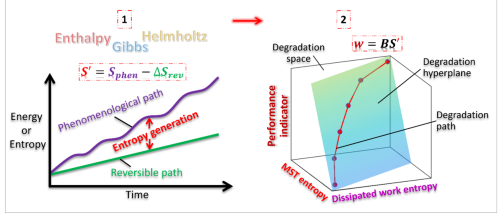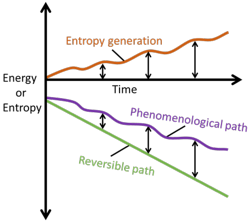The performance and reliability of machines and devices reduce as they age. Currently, inaccurate degradation characterization leads to over- and under-maintenance, both of which have dire consequences on society. Hence, the urgent need for improved methods to optimize system maintenance, prevent failure and reduce costs. After almost a decade investigating the physics of degradation of diverse systems such as frictional interfaces, lubricants, batteries, metallic structures, and others, an international duo of Dr. Jude Osara, Assistant Professor in the Faculty of Engineering Technology and Prof. Michael Bryant (retired) of the University of Texas at Austin, in a 2-part treatise, proposed a universal thermodynamics-based damage characterization methodology to analyze real systems undergoing often complex processes. These works were recently published and featured in Entropy journal: Methods to Calculate Entropy Generation and Systems and Methods for Transformation and Degradation Analysis.
Everything degrades over time. When engineering systems are not actively maintained, they eventually fail, and some failures can be catastrophic, such as in the transportation and construction industries. To mitigate these failures, preventive maintenance—costing billions of euros annually—is required. Accurate degradation characterization is needed to reduce maintenance costs and prevent failures.

Starting from first principles, Jude Osara and Michael Bryant recently developed an approach based on the second law of thermodynamics, which the authors restated as the Phenomenological Entropy Generation (PEG) theorem. It defines a zero-aging path—demarcating the limit of mere existence—as a reference, and an aging path along which all real systems must evolve as they operate or are in use. Combining with the Degradation-Entropy Generation (DEG) theorem, a user-selected performance indicator—any system parameter that can be measured by a sensor—is then directly correlated with the physics of the active process mechanisms.

Figure 1. Illustration of the Phenomenological Entropy Generation (PEG) theorem, showing the ideal zero-aging path (green line) and the aging path (purple curve). Aging/degradation (orange curve) is, therefore, the vertical difference between the paths (see black arrows).
“The PEG theorem is instantaneous and universal, and the analysis algorithm is simple, non-intrusive and inexpensive. If you can measure or estimate temperature and other process parameters such as force, velocity, stress, strain, voltage, current, etc., you are well on your way to evaluating entropy generation for your system. If you can measure or estimate material properties, entropy generation will be yours to do with as you wish. Our approach also characterizes instability and critical phenomena, demonstrated via thermal runaway in lithium-ion batteries.”
This physics-based methodology, which can also be combined with existing approaches, is recommended to researchers, engineers and scientists for use in quantifying realistic temporal changes in their systems.







